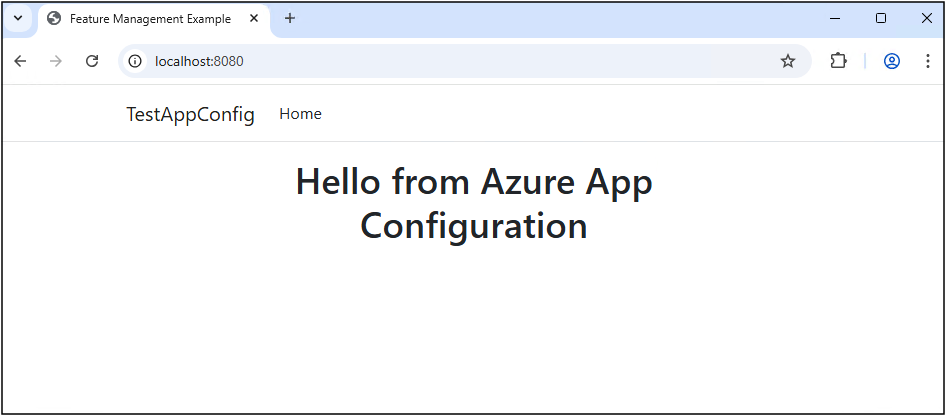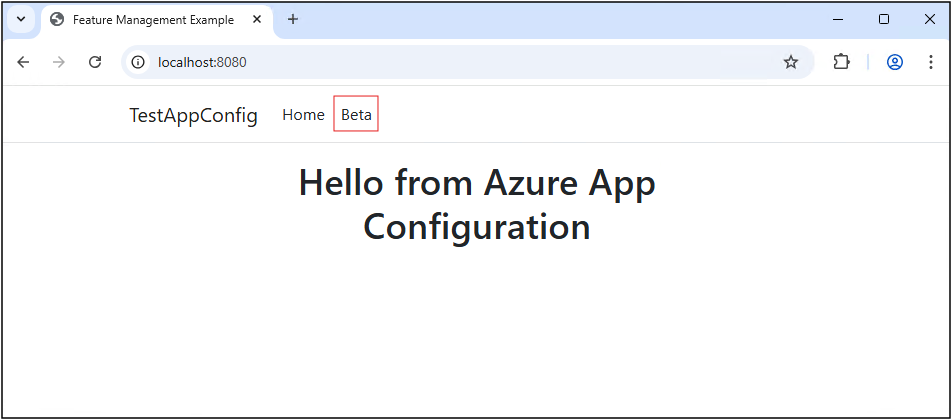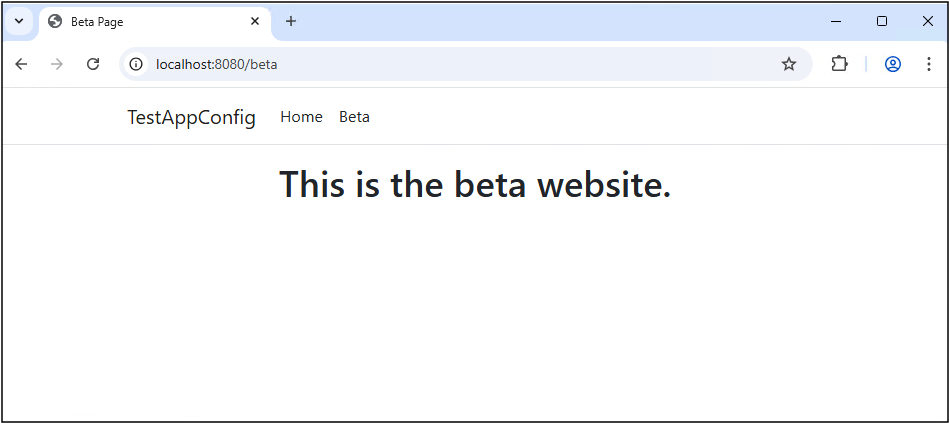Note
Access to this page requires authorization. You can try signing in or changing directories.
Access to this page requires authorization. You can try changing directories.
In this quickstart, you'll create a feature flag in Azure App Configuration and use it to dynamically control the availability of a new web page in a Go Gin web app without restarting or redeploying it.
The feature management support extends the dynamic configuration feature in App Configuration. This example demonstrates how to integrate feature flags into a Go Gin web application with real-time updates and conditional page rendering.
Prerequisites
- An Azure account with an active subscription. Create one for free.
- An App Configuration store. Create a store.
- Go 1.21 or later. For information on installing Go, see the Go downloads page.
- Azure App Configuration Go provider v1.1.0 or later.
Create a feature flag
Add a feature flag called Beta to the App Configuration store and leave Label and Description with their default values. For more information about how to add feature flags to a store using the Azure portal or the CLI, go to Create a feature flag.

Create a Go web application
Create a new directory for your Go project and navigate into it:
mkdir gin-feature-flag-quickstart cd gin-feature-flag-quickstartInitialize a new Go module:
go mod init gin-feature-flag-quickstartInstall the required Go packages for Azure App Configuration, Gin web framework, and feature management:
go get github.com/gin-gonic/gin go get github.com/microsoft/Featuremanagement-Go/featuremanagement go get github.com/microsoft/Featuremanagement-Go/featuremanagement/providers/azappconfigCreate a templates directory for your HTML templates and add the required HTML files:
mkdir templatesAdd the following HTML template files from the GitHub repo and place them in the
templatesdirectory:index.html- The home page templatebeta.html- The beta page template
Use a feature flag
Create a file named
appconfig.gowith the following content. You can connect to your App Configuration store using Microsoft Entra ID (recommended) or a connection string.package main import ( "context" "log" "os" "github.com/Azure/AppConfiguration-GoProvider/azureappconfiguration" "github.com/Azure/azure-sdk-for-go/sdk/azidentity" ) func loadAzureAppConfiguration(ctx context.Context) (*azureappconfiguration.AzureAppConfiguration, error) { // Get the endpoint from environment variable endpoint := os.Getenv("AZURE_APPCONFIG_ENDPOINT") if endpoint == "" { log.Fatal("AZURE_APPCONFIG_ENDPOINT environment variable is not set") } // Create a credential using DefaultAzureCredential credential, err := azidentity.NewDefaultAzureCredential(nil) if err != nil { log.Fatalf("Failed to create credential: %v", err) } // Set up authentication options with endpoint and credential authOptions := azureappconfiguration.AuthenticationOptions{ Endpoint: endpoint, Credential: credential, } // Configure feature flag options options := &azureappconfiguration.Options{ FeatureFlagOptions: azureappconfiguration.FeatureFlagOptions{ Enabled: true, RefreshOptions: azureappconfiguration.RefreshOptions{ Enabled: true, }, }, } // Load configuration from Azure App Configuration appConfig, err := azureappconfiguration.Load(ctx, authOptions, options) if err != nil { log.Fatalf("Failed to load configuration: %v", err) } return appConfig, nil }Tip
When no selector is specified in
FeatureFlagOptions, it loads all feature flags with no label in your App Configuration store. The default refresh interval of feature flags is 30 seconds. You can customize this behavior via theRefreshOptionsparameter. For example, the following code snippet loads only feature flags that start with TestApp: in their key name and have the label dev. The code also changes the refresh interval time to 5 minutes. Note that this refresh interval time is separate from that for regular key-values.azureappconfiguration.FeatureFlagOptions{ Enabled: true, Selectors: []azureappconfiguration.Selector{ { KeyFilter: "TestApp:*", LabelFilter: "dev", }, }, RefreshOptions: azureappconfiguration.RefreshOptions{ Enabled: true, Interval: 5 * time.Minute, }, }Create a file named
main.gowith the following content:package main import ( "context" "fmt" "log" "net/http" "os" "github.com/Azure/AppConfiguration-GoProvider/azureappconfiguration" "github.com/gin-gonic/gin" "github.com/microsoft/Featuremanagement-Go/featuremanagement" "github.com/microsoft/Featuremanagement-Go/featuremanagement/providers/azappconfig" ) type WebApp struct { featureManager *featuremanagement.FeatureManager appConfig *azureappconfiguration.AzureAppConfiguration } func (app *WebApp) refreshMiddleware() gin.HandlerFunc { return func(c *gin.Context) { go func() { ctx := context.Background() if err := app.appConfig.Refresh(ctx); err != nil { log.Printf("Error refreshing configuration: %v", err) } }() c.Next() } } func (app *WebApp) featureMiddleware() gin.HandlerFunc { return func(c *gin.Context) { // Check if Beta feature is enabled betaEnabled, err := app.featureManager.IsEnabled("Beta") if err != nil { log.Printf("Error checking Beta feature: %v", err) betaEnabled = false } // Store feature flag status for use in templates c.Set("betaEnabled", betaEnabled) c.Next() } } func (app *WebApp) setupRoutes(r *gin.Engine) { r.Use(app.refreshMiddleware()) r.Use(app.featureMiddleware()) // Load HTML templates r.LoadHTMLGlob("templates/*.html") // Routes r.GET("/", app.homeHandler) r.GET("/beta", app.betaHandler) } // Home page handler func (app *WebApp) homeHandler(c *gin.Context) { betaEnabled := c.GetBool("betaEnabled") c.HTML(http.StatusOK, "index.html", gin.H{ "title": "Feature Management Example App", "betaEnabled": betaEnabled, }) } // Beta page handler func (app *WebApp) betaHandler(c *gin.Context) { betaEnabled := c.GetBool("betaEnabled") if !betaEnabled { return } c.HTML(http.StatusOK, "beta.html", gin.H{ "title": "Beta Page", }) } func main() { ctx := context.Background() // Load Azure App Configuration appConfig, err := loadAzureAppConfiguration(ctx) if err != nil { log.Fatalf("Error loading Azure App Configuration: %v", err) } // Create feature flag provider featureFlagProvider, err := azappconfig.NewFeatureFlagProvider(appConfig) if err != nil { log.Fatalf("Error creating feature flag provider: %v", err) } // Create feature manager featureManager, err := featuremanagement.NewFeatureManager(featureFlagProvider, nil) if err != nil { log.Fatalf("Error creating feature manager: %v", err) } // Create web app app := &WebApp{ featureManager: featureManager, appConfig: appConfig, } // Set up Gin with default middleware (Logger and Recovery) r := gin.Default() // Set up routes app.setupRoutes(r) // Start server fmt.Println("Starting server on http://localhost:8080") fmt.Println("Open http://localhost:8080 in your browser") fmt.Println("Toggle the 'Beta' feature flag in Azure portal to see changes") fmt.Println() if err := r.Run(":8080"); err != nil { log.Fatalf("Failed to start server: %v", err) } }
Run the web application
Set the environment variable for authentication and run the application.
go mod tidy go run .Open a browser window, and go to
http://localhost:8080. Your browser should display a page similar to the image below.
Sign in to the Azure portal. Select All resources, and select the App Configuration store that you created previously.
Select Feature manager and locate the Beta feature flag. Enable the flag by selecting the checkbox under Enabled.
Refresh the browser a few times. When the refresh interval time window passes, the page displays with updated content:

Notice that the Beta menu item now appears in the navigation bar. Click on it to access the beta page:

Clean up resources
If you don't want to continue using the resources created in this article, delete the resource group you created here to avoid charges.
Important
Deleting a resource group is irreversible. The resource group and all the resources in it are permanently deleted. Ensure that you don't accidentally delete the wrong resource group or resources. If you created the resources for this article inside a resource group that contains other resources you want to keep, delete each resource individually from its respective pane instead of deleting the resource group.
- Sign in to the Azure portal, and select Resource groups.
- In the Filter by name box, enter the name of your resource group.
- In the result list, select the resource group name to see an overview.
- Select Delete resource group.
- You're asked to confirm the deletion of the resource group. Enter the name of your resource group to confirm, and select Delete.
After a few moments, the resource group and all its resources are deleted.
Next steps
In this quickstart, you created a feature flag in Azure App Configuration and used it in a Go Gin web application. The Feature Management Go library provides feature flag capabilities that integrate seamlessly with Azure App Configuration.For more features, continue to the following document.
While a feature flag allows you to activate or deactivate functionality in your app, you may want to customize a feature flag based on your app's logic. Feature filters allow you to enable a feature flag conditionally. For more information, continue to the following tutorial.
Azure App Configuration offers built-in feature filters that enable you to activate a feature flag only during a specific period or to a particular targeted audience of your app. For more information, continue to the following tutorial.